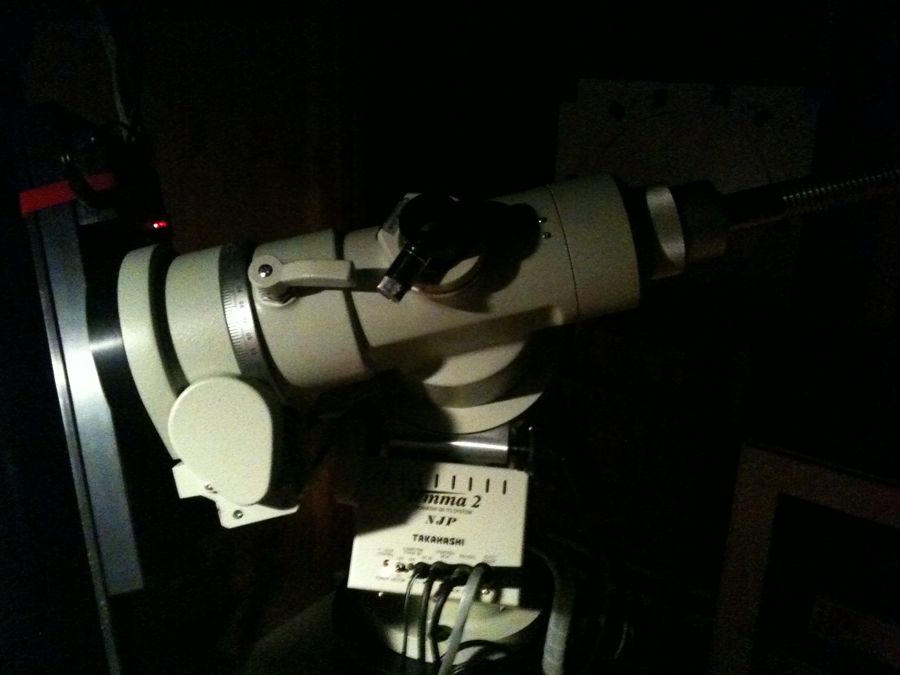I hacked my mount today.
It was a small hack. Just two parameter settings. But I believe it will give me an important piece of functionality.
Where to begin?
The NJP, like all of my mounts have been, is a German Equatorial type. Among other things, what this means is that the mount can track the sky from the eastern horizon up to meridian, or from meridian down to western horizon, but in order to track a single object all night, at some point, it will have to do a 180deg reposition called a “meridian flip” to get from one side to the other. How, when, and how accurately a mount performs a meridian flip is a subject of no little debate amongst amateur astronomers.
Takahashi obviated the whole argument, by making the mount itself (as opposed to the software driving the mount) understand where “the meridian” is, and to require a meridian flip for any objects which are beyond it.
This is all well and good. Except that there is actually a band of sky surrounding the meridian on either side which can be reached with the telescope on either side of the mount. In particular, with my current telescope onboard, I can track an object for about 2 hours before it crosses the meridian, even with the telescope pointing “west”. This means that I can track an object for nearly 8 hours before it sets, giving me maximum imaging time.
But if the mount detects that the object is so much as one minute before the meridian crossing, it will request a meridian flip, so that it can track the object with the telescope pointing “east”, which means I only get to track it for about 2 hours until the telescope crashes into the western side of the pier. Bummer.
I asked around, and discovered that there is no programmatic solution to this; it’s the mount deciding when to request the flip.
Fine. So here’s where my hack comes in.
I told the mount that it’s 2 hours east of its current location. Since each sidereal hour is 15 degrees, I just subtracted 30 degrees from the longitude (making the mount think it’s in Springfield, MO instead of Newark, CA), et voila!
The computer still knows it’s in CA, so all the stars rise and set at the same times they do overhead. And, since the mount get synched to the sky by me actually pointing to a star, then telling the computer “the mount is pointed at this particular star”, all is well. The mount will think it’s pointed 2 hours farther to the west than it actually is, but that won’t hurt anything. Near the horizons, things get a little weird, since the mount thinks it can’t point at anything that’s going to set in the next 2 hours, and can in theory point at things that won’t rise for another 2 hours. But the observatory walls pretty well take care of blocking the horizons anyway. And directly overhead, I can tell the mount “please point at the object that won’t cross the meridian for another hour and 45 minutes” and it happily slews there, no meridian flip required.
I can hear the brighter students in the class asking “but won’t this keep you from slewing to objects properly when you’re pointed eastward?” And the answer is “yes”, but consider: the point of the exercise is to allow easy access to objects so that I can spend maximum time imaging them, without having to flip in the middle of the run. So if I am imaging something to the east, I would want to slew to it well before it reaches meridian-2h, because at meridian-2h, I can only shoot for about 4 hours before I run into the pier. So the slew will happen just fine (since I will carefully select targets that will work). It will just track right on past the meridian without a hitch. And if it ends up being a problem, the hack is always reversible.
Oh, the second setting? I had to set the western safety limit of the mount to 4 hours past meridian, since it will actually stop a little too early on eastward pointing tracks if I set it to the actual meridian+2.
It needs more testing. And of course, I can change the parameters somewhat when I change telescopes (some will allow the mount to bend even further backwards to track near the meridian).
But I think my slews are back to what I would consider “normal”.
Good mount. Do what I mean.
2010.05.01 UPDATE: It works! I told the mount to slew to M87; it was at HA 22:14 (1 hour and 46 min before meridian). Here’s where the mount ended up:
Junky iPhone photo, but that there is one mount that is definitely “bent over backwards” to pick up an easterly target.
w00t!



Clever!
Thanks! I still need to test it under the stars before I really start congratulating myself. (:
The previous GOTO system that I used, Losmandy’s Gemini system, had a much more thought-out system of meridian flips. The Takahashi Temma system generally feels very spartan compared to Gemini, but the Gemini system was sold, alas, with the G-11.
I sure hope the guy who bought my G-11 really enjoys it… *grin*